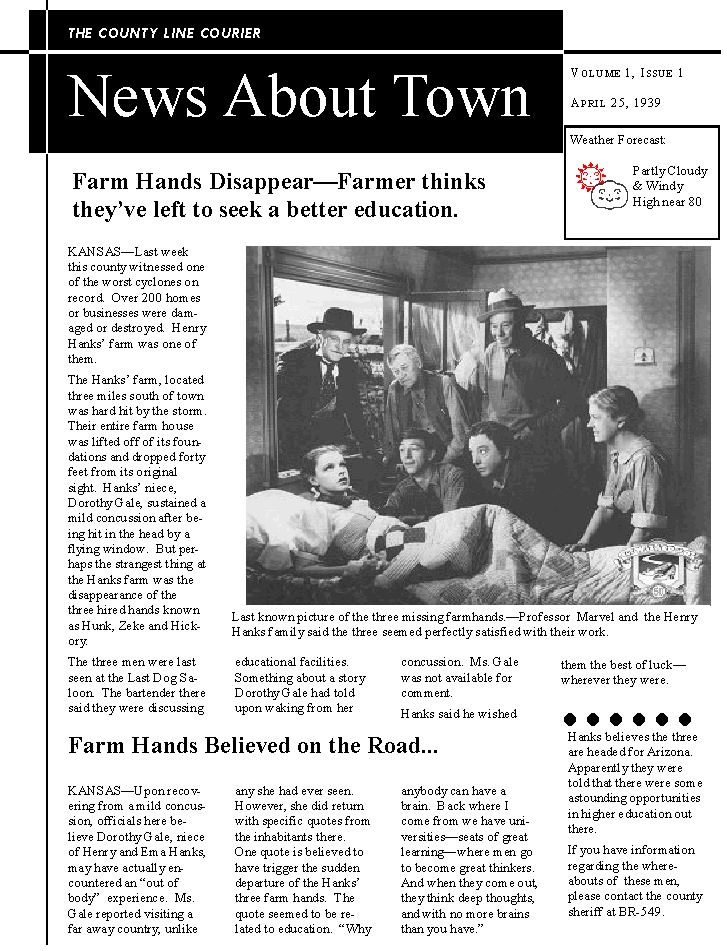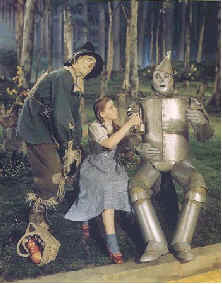|
 Searching
for the “wonder” in learning... Searching
for the “wonder” in learning...
Teaching with Case Studies
TEACHING NOTE
`1The Education of Three Farm Hands
Case Objectives
Upon completion of this case, students will be able to...
1. understand the value of a case study to a variety of course offerings.
2. discuss the various components involved in the development of a good case
study.
3. develop simple case studies for use in their respective classes.
Uses of the Case
This case could be used in a variety of courses and with a wide variety of age
groups. Primarily it was developed for educators, student teachers and
in-service teachers.
The case can be assigned to small groups for discussion and exchanging ideas
before debriefing in a large group. These groups may be asked to consider one or
more of the questions listed below. Teachers might also incorporate written or
oral communications exercises within their case teaching strategy.
Questions for Discussion
1. From the point of view of Henry Hanks, what did the farm hands do to upset
his livelihood?
2. From the point of view of the county sheriff, what concern should he have
over the disappearance of these three men?
3. Explain whether or not you believe that Dorothy had an out of body
experience? 4. What values can be attached to Dorothy's experience as she
related it to the three farm hands?
5. Why would the three farm hands want to continue their education at this
point?
6. What logical steps would they take to achieve that goal?
7. Based on what you know about these men, do you believe the inheritance
would be important to them? ...enough to cause them to leave?
8. What lessons can be learned from this case?
Enrichment Activities
The following ideas are intended to be student-centered activities that could
enhance and complement discussions about the case.
v Students role-play the parts of the three farm
hands and their discussion with Dorothy after she hit her head.
v Watch video clips of the movie to
determine more about the likes and dislikes of the three farm hands.
v Have students utilize the internet to
collect information on the three major universities in Arizona for comparison
with the personalities of the three farm hands.
v Utilize the steps below to show
educators how to utilize a simple case study:
· Read the case individually.
· Discuss what the case is about and why
the issues raised might be important in a disciplinary or interdisciplinary
course?
· Define your educational objectives in
using this case in a specific class. o Describe how you would assign the case to
the students and what approach you would use to engage them in the case before
discussing it in class.
· Decide on an opening question that you
would use to begin the whole class discussion of the case. What would you hope
to achieve by using this question?
· How would you have the students respond
to the case and how would you assess what they had learned through the case
experience?

The Education of Three Farm Hands
Introduction
Sometime in early 1934, three homeless men found work on the Henry Hanks
farm. For the next five years they worked, played and cried along with the
family that owned the farm. Their emotional attachments grew when the Hanks’
young niece, Dorothy, came to live on the farm. Times were hard and money was
scarce. The farm hands were sometimes paid with produce rather than cash. Even
so they were loyal employees, often remarking on the quality of Mrs. Hanks’
cookies.
In the spring of 1939, one of the worst twisters on record ravaged the Hanks
farm. During the storm Dorothy received a light concussion rendering her
unconscious for several hours. When she awoke she regaled the entire family and
crew about what seemed to be a very real experience for her. Shortly thereafter
the entire crew—Zeke, Hunk, and Hickory disappeared. They left no word and
absolutely no one knew where they had gone.
Officials searched for evidence as to the men’s whereabouts to no avail.
Foul play was suspected, but then dismissed due to lack of any concrete
evidence. The dilemma at hand revolved around a surprise inheritance by one of
the three men. The location of that individual had to be found in order to
dispense the fortune.
Background
Zebediah (Zeke) Thomas was born in southern Illinois. Always looking for a
way to achieve fame and fortune, Zeke left home at the age of 16. He worked his
way across the country traveling with a wheat combining crew. It was a large
outfit and Zeke made a good hand. Unfortunately, three days after his 17th
birthday he watched a close friend slip and fall under the hooves of the
twenty-mule hitch that ran the big machine. Unreasonable bouts of fear invaded
Zeke’s life and soon he left the crew and went in search of a different
calling. He spent ten years traveling around the country before settling in on
the Hanks’ farm.
Ray (Hunk) Andrews had been a city boy. He grew up in Chicago where his dad
worked at one of the largest meat packing-houses in the world. One of seven
children, Hunk greatly admired his oldest brother, Sam. Sam always said you
could never get anywhere in this world unless you had a good education.
Unfortunately, the Great Depression hit before Hunk graduated high school. In
fact, he was forced to quit school and go to work to help support the family.
Three years later with his three sisters married and his three brothers all
employed, Hunk left Chicago to see more of the world—and get an education on
the road.
Jack (Hickory) Twicker, was born with a gift for carving wood. Like his
father before him he apprenticed to become a great furniture maker.
Unfortunately, there was little demand for quality furniture at the beginning of
the Depression. Hickory was laid off of his job at the Louisville Hampton
Furniture company. Two years later he was living at home with his widowed
mother. Due to an unfortunate accident she passed on, leaving Hickory alone in
the world. He decided to head west and seek his fortune.
The Decision
Officials must decide how to locate the men and if that proves impossible, to
decide what to do with the inheritance.

The County Line Courier
 News About Town News About Town
Competency:
Using various methods to involve students in the
teaching-learning process.
Objectives:
To introduce you to an alternative teaching method.
To provide you with the basic format for constructing your own case studies.
To provide you with examples and resources related to the topic.
What are Decision Cases?
Critical thinking is the
intellectually disciplined process of actively and skillfully conceptualizing,
applying, analyzing, synthesizing, and /or evaluating information gathered from,
or generated by, observation, experience, reflection, reasoning, or
communication, as a guide to belief and action.
The decision case is a synopsis
of a real-life dilemma that remains unsolved to the reader. It is based on
reality and therefore contains factual information.
Decision cases are active learning processes centered on
organizing discussion around the problem.
In preparing to utilize cases in a specific class, several
questions must be addressed:
 | What number and type of cases would you use? |
 | What would be the sequence of cases in relation to each
other? |
 | What would be the relationship of the cases to other
teaching methods and materials used in the course? |
 | How could group activities and processes be used in
conjunction with these cases? |
 | What enrichments might be used to heighten student
motivation? |
 | How would you evaluate student performance and learning
when using cases? |
Classroom Approaches
The Role of the
Educator
Often teaching is turned into a performance where we feel we
must be “the sage on the stage”. A major difference between teaching with
decision cases and traditional approaches is that the teacher acts as a
facilitator of the learning process rather than a performer.
Case teaching is not easy. A teacher must be able to think
ahead, reorganize and listen at the same time. Case teaching is not a rambling
process without focus. The teacher must have a plan in mind before beginning the
case discussion. Seldom are two decision case discussions the same.
Preparing for Decision Case Discussions
Objectives and
Material
Preparing Objectives Objectives are vital to case teaching.
They are the glue that hold the discussion together and prevents it from
turning into a “bull session.”
Familiarizing yourself with the material Decision case
teaching requires students to reason from the facts presented in the case.
They are more able to do this if the case teacher is sure of the facts and
attempts to present the essential aspects of the case. A conceptual outline
which parallels the objectives may be helpful. This helps the teacher think
and prepare for various topics or concepts that may be covered during the
discussion. However, a good discussion rarely proceeds in the logical pattern
of a structured outline.

Preparing a question
outline
Prepare a question outline to match the concept outline.
Questioning is the single most important skill case teachers must develop.
Questions should promote discussion about the concepts to be understood rather
than solicit the correct answer. Most students have been trained to think there
is only one right answer to a question. They think the teacher knows it and that
they will be rewarded when they say it. This kind of mindset can kill case
discussions. The best way to encourage creative answers is to phrase questions
that do not call for right answers.
Teaching Socratically
Only when answers generate further questions does thought
remain alive. Only students who have questions are really thinking and learning.
The quality of the questions we ask determines the quality of the thinking we
do. Socratic questioning recognizes that questions,
not answers, are the driving force in thinking.

Preparing for Decision Case Discussions
Foundation
questions
There are five basic questions that serve as a foundation of
case discussions:
 | What makes this case a dilemma? |
 | What are the objectives of the decision maker in
resolving the dilemma? |
 | What are the issues involved in this case? |
 | What are the options of the decision maker? |
 | What decision should the decision maker make? |
It is helpful to think through these questions ahead of
time and determine which points you would like to see discussed.
Using a board outline
An effective strategy for case teachers is to make use of the
chalkboard to help organize discussions that may at times seem to be going off
in many directions at once. By doing so, students will also have a chance to see
their contributions to the discussion validated. Teachers can organize the
outline by the key questions asked or by topic of the discussion. The Teaching
Note may contain other options.

Arranging the Classroom
Most classrooms are arranged in rows so that the teacher is
the focal point; however, this physical setting can stifle effective case
teaching.
The ideal situation is to arrange the seats in a “U” or
horseshoe shape so the students can easily see one another and the case teacher
can get close to the students and move to the blackboard.
Special recognition:
These thoughts and examples were compiled from a variety of
sources. Those sources include: Decision Cases for Secondary Educationt,
Brakke, Dunrud, Peterson, Marla Reicks, & Simmons with Bakkum, Bowman, Pitzl,
and Stanford (1994) . College of Agriculture , University of Minnesota, Critical
Thinking Website—Foundation for Critical Thinking , Methods of Teaching
Agriculture, Newcomb, McCracken and Warmbrod (1993) and The Power
of Positive Teaching, McCormick (1994).

| 
 The University of Arizona
The University of Arizona![]()